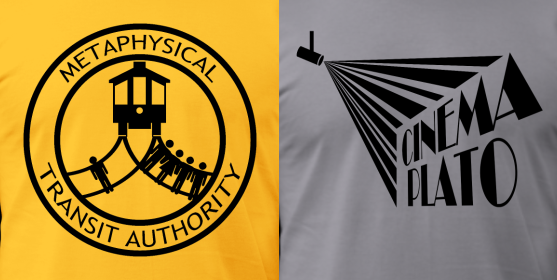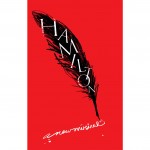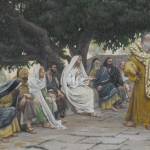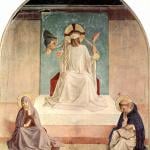The first time I ran into Google Hangout’s facial recognition feature, I had a lot of fun trying to find the limits of what it would recognize as a face. I grabbed photos, drawings, etc and held them up while ducking below my webcam’s sightline and then trying to compete with the faux-face to try to suss out how the algorithm decided. But Neil Yager has coded up a prototype that wouldn’t be fooled.
He built a camera/infrared sensor that recognizes faces and then double checks whether those faces have a realistic heat signature. His detector successfully notices photographs and people wearing silicon masks as faux faces. He walks through the how and you can skim or dig into the code yourself.
About two weeks ago, people surrounded the Flatiron building in New York City for a live demonstration of the Pythagorean Theorem. The event, hosted by the Museum of Math, had volunteers line up on the sidewalk, measuring the perimeter of the building at street level and checking that the squares of the two legs really did equal the square of the hypotenuse.
I wonder what good math events I could organize at home. Of course, the in situ math I love best would still be walking the bridges of Königsberg. Though, due to the bombing of the city in WWII, there now exists an Eulerian path for the city.
And if I were travelling through Europe on a science/math safari, I would have to stop by the Alnwick Poison Garden (h/t Leigh Bardugo). This English garden has deadly plants, some so dangerous that they’re behind screens, to prevent passerby from touching them and succumbing.
Plus, this is what the gates look like:
You’d hate to see any of the plants from that garden at the dinner table, but that’s not the only kind of dining treachery to fear. There’s an awesome game theory dinner, also occurring in England.
“The Betrayers’ Banquet is an experimental dining experience from London, where guests play the iterated prisoner’s dilemma to win a better or worse meal. Each of the 48 participants is served eight different courses over two hours; two starters, four mains and two desserts. While all dishes are edible, their allure differs considerably between the top and the bottom of the table; those at the top will enjoy a fine dining experience to match any in London, while those at the bottom will grapple with pickled walnuts, chicken’s feet soup, lumpy gruel, and worse.”
At regular intervals during the dinner, guests are invited to play the prisoner’s dilemma with their opposites. If they both cooperate, they move up the table by six places. If they both betray, they move down the table by six places. If one cooperates and the other betrays, the betrayer moves up ten places, and the other down ten.
When I read The Girl with a Pearl Earring, I loved all the descriptions of the how of Vermeer’s painting. I liked seeing what minerals were ground for what colors and how the colors were layered in the composition. And I quite enjoyed the cameo by Leeuwenhoek with his camera obscura.
That last is a little controversial. Art historians still debate whether Vermeer used the instrument to help him achieve his realistic painting. But Tim Jenison has applied a little empiricism. He used a camera obscura to try to replicate Vermeer’s hypothetical technique and to see how it fell short or matched some of the quirks of the master’s style. Penn and Teller ended up chronicling his work for a documentary (trailer below):
But the data I found most charming was this excerpt from a Vanity Fair feature on the project:
For his experimental purposes—using a device that Vermeer himself could have made—Jenison decided that modern lenses are too fine. So he learned how to make lenses himself, to melt and polish glass using 17th-century techniques. Jenison painted only with pigments available in the late 1600s and learned to mix them himself, including grinding lapis lazuli stones (“they’re kind of poisonous,” he points out) to make ultramarine blue.
Vermeer painted The Music Lesson in a first-floor room in his mother-in-law’s house. “We know, historically, everything about that room in Delft. And this building”—Jenison was now referring to his little one-story warehouse in Texas—“has the same north-northwest angle to the sun.” Because the buildings across the Oude Langendijk canal would have blocked some of the light, Jenison erected false Dutch façades outside on the San Antonio pavement. Inside, piece by piece, he constructed a life-size reproduction of Vermeer’s room—wooden beams, checkerboard floor, plastered walls. He had the porcelain platter made, and the pitcher on it, by a potter in Delft. He made the chair himself, copying one in a Delft museum. He also built the prop harpsichord. “I started off going as authentic as possible,” Jenison says. “I realized I could commission or learn to make stained glass. But I decided I didn’t need another major hobby at that point in time. I cheated on the glass.” The stained-glass windows are in fact stained Plexiglas. All the physical preparations took about eight months.
Also from the annals of Imitation is the Sincerest Form of Flattery, the students at Harvard Med have brilliantly pastiched “What Does the Fox Say?” with “What Does the Spleen Do?”
(You can tell you’re too excited about malaria if you keep involuntarily hissing “It filters blood! Hence hyperspleenia in malaria patients!” during the video).
And finally, if you’re looking for a nerdy philosophy shirt for a friend (or yourself) during the holidays, I just want to remind you about the existence of the Trolleyology and Allegory of the Cave my friends and I designed and sell on Spreadshirt.
And, this week, we added a new shirt to the lineup, when a friend asked for a shirt that would indicate that he cooperated on Prisoner’s Dilemmas and I made him this:
And speaking of cooperating, you’d be doing me a big favor if, when you’re buying gifts on Amazon, you get to Amazon by clicking any of the book links on last week’s Quick Takes. Your prices remain the same, but I get a small percentage of Amazon’s take for referring you. And I’ll probably use it buying more books to review.
For more Quick Takes, visit Conversion Diary!
I’m on (a belated) day nine of a novena to St. Isidore, my saint for the month, and readers are welcome to join me.
















